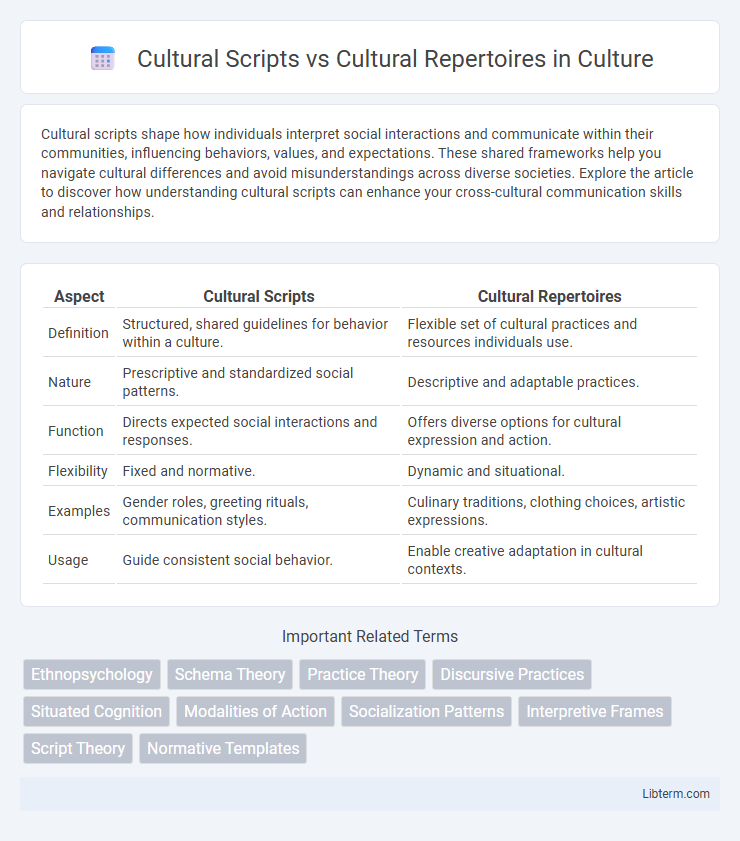Cultural scripts shape how individuals interpret social interactions and communicate within their communities, influencing behaviors, values, and expectations. These shared frameworks help you navigate cultural differences and avoid misunderstandings across diverse societies. Explore the article to discover how understanding cultural scripts can enhance your cross-cultural communication skills and relationships.
Table of Comparison
| Aspect | Cultural Scripts | Cultural Repertoires |
|---|---|---|
| Definition | Structured, shared guidelines for behavior within a culture. | Flexible set of cultural practices and resources individuals use. |
| Nature | Prescriptive and standardized social patterns. | Descriptive and adaptable practices. |
| Function | Directs expected social interactions and responses. | Offers diverse options for cultural expression and action. |
| Flexibility | Fixed and normative. | Dynamic and situational. |
| Examples | Gender roles, greeting rituals, communication styles. | Culinary traditions, clothing choices, artistic expressions. |
| Usage | Guide consistent social behavior. | Enable creative adaptation in cultural contexts. |
Understanding Cultural Scripts
Cultural scripts are shared, context-specific patterns of behavior and communication that guide individuals on how to act appropriately in social situations within a particular culture. They serve as implicit frameworks for interpreting social interactions, shaping expectations and responses based on cultural norms and values. Understanding cultural scripts enhances cross-cultural communication by revealing the underlying rules that govern behavior and preventing misunderstandings.
Defining Cultural Repertoires
Cultural repertoires refer to the dynamic collection of practices, norms, symbols, and behaviors that individuals or groups draw from to navigate social contexts and express identity. Unlike cultural scripts, which are fixed sequences of expected behaviors in specific situations, cultural repertoires offer flexible options that can be selectively employed depending on circumstance and personal choice. This concept highlights the variability and adaptability inherent in cultural expression, emphasizing how culture serves as a resource for creative social action.
Origins and Development of Cultural Scripts
Cultural scripts originate from shared cognitive frameworks and social norms developed through enduring interactions within a community, serving as implicit guides for behavior and communication. They evolve over time as cultural repertoires expand, incorporating diverse behaviors, practices, and symbolic meanings that individuals draw upon selectively. The development of cultural scripts is deeply influenced by historical context, language, and collective memory, shaping predictable patterns of social conduct.
Evolution of Cultural Repertoires
Cultural repertoires evolve through the dynamic adaptation of cultural scripts, which are the established patterns of behavior and meaning within a community. Unlike fixed cultural scripts, repertoires encompass a broader and more flexible set of practices that individuals draw upon to navigate social situations, allowing cultures to respond to changing environments and influences. This evolution reflects the continual negotiation and reinterpretation of cultural elements, facilitating diversity and innovation in social behavior over time.
Key Differences Between Scripts and Repertoires
Cultural scripts refer to predefined, shared sequences of behaviors or norms that guide social interactions within a specific cultural context, emphasizing predictability and conformity. Cultural repertoires encompass a broader range of adaptive behaviors, skills, and resources that individuals draw upon flexibly to navigate diverse social situations. The key difference lies in scripts providing structured, context-specific guidance, while repertoires offer a dynamic, versatile toolkit for cultural expression and problem-solving.
Functions in Social Communication
Cultural scripts function as shared, normative templates guiding behavior and interaction in specific social contexts, helping individuals anticipate appropriate responses and maintain social harmony. Cultural repertoires consist of a broader set of communicative tools, including styles, expressions, and practices, which individuals selectively deploy to navigate diverse social situations and express identity. Together, they enable effective social communication by structuring expectations and providing flexible means to adapt interactions across varied cultural settings.
Influence on Identity and Behavior
Cultural scripts shape individual identity by providing unwritten rules that guide behavior within specific social contexts, influencing how people perceive themselves and interact with others. Cultural repertoires encompass a broader array of knowledge, practices, and symbols individuals draw upon, allowing flexible adaptation and expression of identity across varying situations. The dynamic interplay between cultural scripts and repertoires impacts social behavior by balancing conformity with personal agency in cultural expression.
Cultural Scripts in Everyday Contexts
Cultural scripts in everyday contexts guide social interactions by providing shared expectations and norms that shape behavior and communication patterns. These scripts help individuals navigate roles, rituals, and routines within their cultural environment, influencing language use and nonverbal cues. Understanding cultural scripts enhances cross-cultural competence and fosters effective interpersonal relationships in diverse settings.
Adaptability of Cultural Repertoires
Cultural repertoires exhibit high adaptability as they encompass a broad range of behaviors, practices, and symbols that individuals can selectively apply based on situational context. Unlike rigid cultural scripts, which prescribe fixed, linear sequences of actions, cultural repertoires allow flexible interpretation and modification, supporting dynamic responses to social and environmental changes. This adaptability enhances individuals' capacity to navigate diverse social settings and evolving cultural landscapes effectively.
Implications for Cross-Cultural Research
Cultural scripts provide structured, normative patterns of behavior within a society, serving as cognitive frameworks that guide individuals' actions and interpretations across contexts. Cultural repertoires encompass a broader range of flexible practices and symbolic resources individuals draw upon, allowing adaptation and variation in behaviors even within a single cultural setting. Recognizing the distinction between culturally prescribed scripts and the dynamic use of repertoires informs cross-cultural research by emphasizing context-dependent variability and preventing oversimplified, static comparisons across cultures.
Cultural Scripts Infographic

 libterm.com
libterm.com